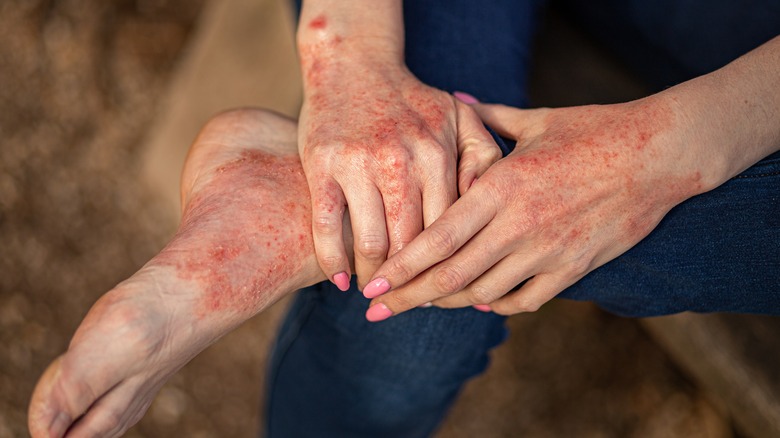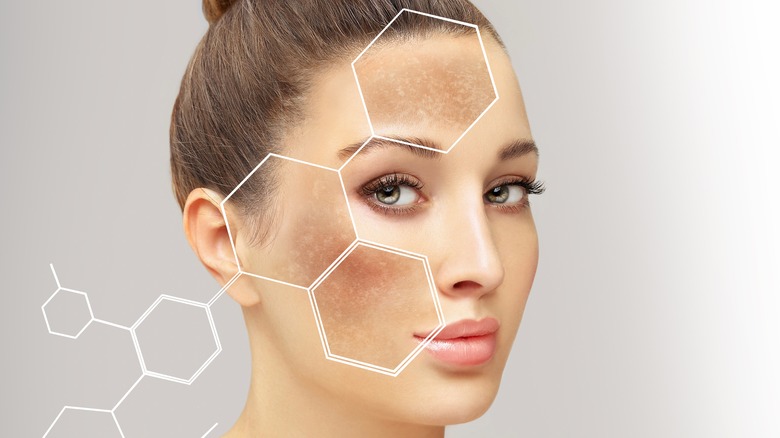What The Color Of Rough, Dry Patches Says About Your Skin (And How To Treat It)
Our skin is one of the most noticeable things about us — remember when your 4th-grade classmates used to tease you by saying, "Your epidermis is showing?" So, when we spot any kind of skin imperfection, whether it's an acne outbreak, a pregnancy stretch mark, or an age spot, it sets off a chain reaction of self-consciousness, followed by a desperate search for a remedy.
Among the epidermal ailments we're most likely to encounter in our lifetime is skin dehydration. Often caused by cold weather, frequent hand washing, soaps with strong chemicals, or just not drinking enough water, dry skin is typically characterized by dry or rough patches, cracking or scaling, bleeding, tightness, and/or itchiness. Staying hydrated inside and out, regular moisturizing, and proper protection during summer and winter are all effective in most cases of dry skin.
But then there are other skin conditions that may require a different type of treatment. Many also involve rough, dry patches that are also discolored in some way. Below are a few such skin abnormalities to be aware of. Remember that if you notice a change in the look or feel of any part of your skin — particularly if it comes on suddenly, or worsens — it's always best to consult your doctor.
Dry red skin can be a symptom of eczema
If you have dry, red, or bumpy patches on your face, hands, feet, inside your elbows, or behind your knees, chances are it's a form of eczema. The patches may also itch or blister. The National Eczema Association explains that the most common type of eczema, atopic dermatitis, is thought to be an environmental allergic reaction with a genetic component. People whose parents or siblings suffer from atopic dermatitis are more likely to have it themselves.
Flare-ups can occur when the weather is very hot or cold, or when the sufferer comes into contact with an allergen such as animal dander or pollen. There's no cure for eczema, but there are ways to prevent outbreaks or keep them from getting worse. Avoiding extremes in temperature and keeping your skin moisturized are two important strategies.
People prone to dermatitis are advised to bathe in warm (not hot) water, avoid scented soaps, and apply an extra-strength lotion or cream immediately afterward. Using a humidifier in the bedroom in the winter can be helpful as well. For more stubborn cases, a dermatologist can prescribe an oral or topical steroid; other treatments for eczema include UV light therapy.
A dark patch could be a sign of diabetes
Less common than eczema — and harder to pronounce — is a condition called acanthosis nigricans. It causes undefined dark patches in areas such as the folds of the neck, armpits, groin, and elbows, the texture of which is often described as "velvety." According to the National Library of Medicine, the condition occurs most often in obese individuals, Black or Hispanic populations, and people under 40.
It's most often caused by diabetes or insulin resistance, although a number of other conditions — including hypothyroidism, Cushing's disease, and polycystic ovarian syndrome — can also result in such skin patches forming on the body. In the majority of cases, acanthosis nigricans is harmless and resolves itself once the underlying condition is treated (such as losing weight or beginning treatment for diabetes).
However, it can also be a rarer symptom of certain kinds of malignant cancer, so it's important to see a doctor if you notice a darkening area of your skin.
Your skin patch may be pregnancy-related
As if heartburn, weird dreams, and odd food cravings weren't enough to deal with over a single nine-month period, your skin can also be affected by pregnancy. Expectant moms are prone to a condition called melasma, i.e. brown or blue-gray patches appearing on the face, or any part of the body exposed to the sun. The Cleveland Clinic points out that while anyone can develop it, melasma is so common in pregnant women that it's often called the "mask of pregnancy."
The surge in hormones triggers the skin cells to produce an excess of melanin, the pigment that colors skin. Melasma patches are most noticeable in the summer or during any other warm-weather period. Thankfully, melasma isn't a sign of a more serious condition, and usually fades or disappears after a few months. It's still best to tell your doctor to ensure the patches really are melasma. Skin brightening creams can also help reduce the darkness until it improves on its own.
Flaky patches may mean psoriasis
Another common skin condition is psoriasis, which affects over 8 million people in the U.S. alone. The most common variety, known as plaque psoriasis, is characterized by rough, red patches on the knees, elbows, scalp, and other areas of the body, overlaid with scales that range in color from silvery white to purple or brown, depending on one's skin color. The patches may itch, crack, or bleed.
Per WebMD, psoriasis is a chronic inflammatory immune condition in which the skin cells grow more quickly than they're shed. In up to one-third of cases, sufferers may also develop painful psoriatic arthritis in their joints. There is no cure for psoriasis, but it can be treated with various remedies depending on the severity of the case.
Milder cases can be soothed with prescription topical creams or coal tar-based shampoo for plaques on the scalp. More serious cases, however, may require more potent medications. Although there's no proof that certain foods can cause flare-ups, it may also help to keep to an anti-inflammatory diet as part of a complete treatment plan.




